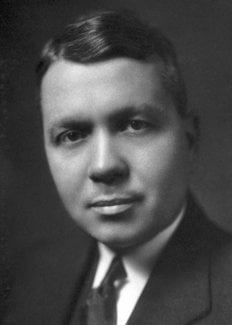Harold C. Urey
Biographical

Harold Clayton Urey was born in Walkerton, Indiana, on April 29, 1893, as the son of the Rev. Samuel Clayton Urey and Cora Rebecca Reinoehl, and grandson of pioneers who settled in Indiana. His early education in rural schools led to his graduation from high school in 1911 after which he taught for three years in country schools. In 1914 he entered the University of Montana and received his Bachelor of Science degree in Zoology in 1917. He spent two years as a research chemist in industry before returning to Montana as an instructor in Chemistry. In 1921 he entered the University of California to work under Professor Lewis and he was awarded the degree of Ph.D. in Chemistry in 1923. He spent the following year in Copenhagen at Professor Niels Bohr‘s Institute for Theoretical Physics as American-Scandinavian Foundation Fellow to Denmark and on his return to the United States he became an Associate in Chemistry at Johns Hopkins University. In 1929 he was appointed Associate Professor in Chemistry at Columbia University and he became Professor in 1934; during the period 1940-1945 he was also Director of War Research, Atomic Bomb Project, Columbia University. He moved to the Institute for Nuclear Studies, University of Chicago in 1945 as Distinguished Service Professor of Chemistry and became Martin A. Ryerson Professor in 1952. He was George Eastman Visiting Professor, University of Oxford, during 1956-1957 and in 1958 he took his present post as Professor-at-Large, University of California.
Professor’s Urey’s early researches concerned the entropy of diatomic gases and problems of atomic structure, absorption spectra and the structure of molecules. In 1931 he devised a method for the concentration of any possible heavy hydrogen isotopes by the fractional distillation of liquid hydrogen: this led to the discovery of deuterium. Together with the late Dr. E.W. Washburn, he evolved the electrolytic method for the separation of hydrogen isotopes and he carried out thorough investigations of their properties, in particular the vapour pressure of hydrogen and deuterium, and the equilibrium constants of exchange reactions. He later worked on the separation of uranium isotopes and, more recently, he has been concerned with the measurement of paleotemperatures, investigations into the origin of the planets, and the chemical problems of the origin of the earth.
He is the author of the books Atoms, Molecules and Quanta (1930, with A.E. Ruark), and The Planets (1952). He was editor of the Journal of Chemical Physics during 1933-1940 and he has written numerous papers on the structure of atoms and molecules, the discovery of heavy hydrogen and its properties, separation of isotopes, measurement of paleotemperatures and the origin of planets. These have been published in many different chemical journals.
Professor Urey received the Willard Gibbs Medal (American Chemical Society) in 1934; Davy Medal (Royal Society, London), 1940; Franklin Medal, 1943; Medal for Merit, 1946; Cordoza Award, 1954; Honor Scroll Award (American Institute of Chemists), 1954; Joseph Priestley Award, 1955; Alexander Hamilton Award, 1961; and the J. Lawrence Smith Award (National Academy of Sciences), 1962. He has received honorary Doctor of Science degrees of Montana, Princeton, Newark, Columbia, Oxford, Washington and Lee, McMaster, Yale, Indiana, Birmingham Universities, and of the Universities of Athens, Durham, and Saskatchewan; also honorary Doctor of Law degree from Wayne University and the University of California. He is a member of many of the more important scientific societies of the world, and is Honorary Fellow of the Chemical Society (London), the National Institute of Sciences of India and the Weizmann Institute of Science (Israel).
In 1926 he married Frieda Daum. They have three daughters and one son.
This autobiography/biography was written at the time of the award and first published in the book series Les Prix Nobel. It was later edited and republished in Nobel Lectures. To cite this document, always state the source as shown above.
Harold C. Urey died on January 5, 1981.
Nobel Prizes and laureates
Six prizes were awarded for achievements that have conferred the greatest benefit to humankind. The 12 laureates' work and discoveries range from proteins' structures and machine learning to fighting for a world free of nuclear weapons.
See them all presented here.
